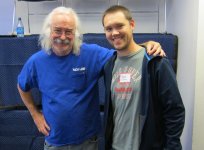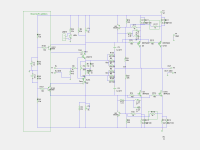Christian, I'm sure it's been discussed somewhere, but have persons placed a coupling cap between the input jacks and the boards in the F5 to protect against DC coming out of a preamp (OR CD player, etc.)? If so, is there a noticeable change in sound quality, and what size cap is typically used? Seems to me that a coupling cap on the output of the preamp (internal) would be no different than on the input of the F5.
Steve
Steve
I can recommend a DC blocking capacitor acting as a passive single pole high pass filter with a F-3dB roll off of 1Hz to 2Hz. This can be had from an RC time constant of 80ms to 160ms.
1uF & 100k = 100ms
1uF & 160k = 160ms
470nF & 180k = 84.6ms
2u2F & 39k = 85.8ms
You choose any plastic film capacitor you like and then select the Rin resistor to get the filter at least a decade below the lowest audio frequency you want to pass.
You can place the DC blocking capacitor at the output of the Source and hope that it will suit any Receiver you connect to, or place the cap at the input of the Receiver where you know the input impedance. Both locations block the DC. But do not use two DC blocking capacitors. Only one is required.
1uF & 100k = 100ms
1uF & 160k = 160ms
470nF & 180k = 84.6ms
2u2F & 39k = 85.8ms
You choose any plastic film capacitor you like and then select the Rin resistor to get the filter at least a decade below the lowest audio frequency you want to pass.
You can place the DC blocking capacitor at the output of the Source and hope that it will suit any Receiver you connect to, or place the cap at the input of the Receiver where you know the input impedance. Both locations block the DC. But do not use two DC blocking capacitors. Only one is required.
I suspect it oscillated once again. (But I need to look at the new preamp to see whether there were coupling caps to output, or whether there was any possibility of DC on the outputs.
If you suspect oscillation I recommend that you try inserting some
resistance, say 100 ohms between the Emitters of the cascode transistors
and the Drains of the input Jfets. This will tend to fix oscillation which is
resistant to the usual other approaches.
Nelson - thanks so much for the suggestion. Your kindness continues. If I encounter any further evidence of instability, I certainly will make this my next step.
I grabbed a photo of you and my son in 2012 after we built our first F5. Five years later I have built 4 of them now. Each one seems to sound better, but the placebo effect is strong.
Steve
I grabbed a photo of you and my son in 2012 after we built our first F5. Five years later I have built 4 of them now. Each one seems to sound better, but the placebo effect is strong.
Steve
Attachments
I can recommend a DC blocking capacitor acting as a passive single pole high pass filter with a F-3dB roll off of 1Hz to 2Hz. This can be had from an RC time constant of 80ms to 160ms.
1uF & 100k = 100ms
1uF & 160k = 160ms
470nF & 180k = 84.6ms
2u2F & 39k = 85.8ms
You choose any plastic film capacitor you like and then select the Rin resistor to get the filter at least a decade below the lowest audio frequency you want to pass.
You can place the DC blocking capacitor at the output of the Source and hope that it will suit any Receiver you connect to, or place the cap at the input of the Receiver where you know the input impedance. Both locations block the DC. But do not use two DC blocking capacitors. Only one is required.
Andrew - thanks so much.
Steve
On checking out the Marantz providing the preamp output, one channel had no DC, and the other had 3 mV. I installed the high pass filters suggested by Andrew, regardless.
The new boards were installed and the amplifier sounded great. This time I biased at 0.65 amp and the top of the heat sinks ran no warmer than 122 F, significantly cooler than at 0.7 amp. The photo below is the final square wave at 1 KHz, 1 watt into 8 ohms. Thanks, everyone.
The new boards were installed and the amplifier sounded great. This time I biased at 0.65 amp and the top of the heat sinks ran no warmer than 122 F, significantly cooler than at 0.7 amp. The photo below is the final square wave at 1 KHz, 1 watt into 8 ohms. Thanks, everyone.
Attachments
Steve - do you now have a pair with identical (or at least really close) gains for the LXmini speakers?
Hi cviller,A while ago, I ordered a small batch of those boards that toxic ingestion have discussed in this thread. I was lucky enough to be able to add the capacitors before I sent the file for production, so I have named the version F5c V2.2. Otherwise, the board is identical to the one described in this thread.
To keep things organised, I have placed in on my simple order site:
F5c V2.2 (cascode-able)
It connects to paypal, but I have not used the site for a few years, so please email me if you run into issues. And also email me if you have questions - I have turned off PM because I forget to go in and reply to PM messages.
Do you still have any of those boards available? Some time ago i dropped the idea of building the F5 beacuse of too small heatsinks.
Now finally have some that will do the job.
Regards,
Marijan
P.S. Your site is unavailable at the moment.
Yes I still have more available, but I have not connected the server since we moved in march. I'll be back from camping after next week and then I'll hook up the server and contact you.
I booted up my server and it seems to work - let me know if you have any issues ordering. My site is cviller order site
I'm in the middle of a moving mess (again) and have not gotten around to setting up my server. In the meantime - what issues are you experiencing?
Basically the same as described in this thread, One N Channel Moosfet acting weird, please have a look at this thead
Cviller F5C, vastly different current draw between two IRFP240
Cviller F5C, vastly different current draw between two IRFP240
Cviller F5C v2.2
I have 2 pairs of Cviller's F5C (Cascode Version) Ver. 2.2 boards listed in the Swap Meet
Charles
FS: DiyStore & Cviller PCBs
I have 2 pairs of Cviller's F5C (Cascode Version) Ver. 2.2 boards listed in the Swap Meet
Charles
FS: DiyStore & Cviller PCBs
- Home
- Amplifiers
- Pass Labs
- F5c (cascode) cviller boards 40 V rails build



